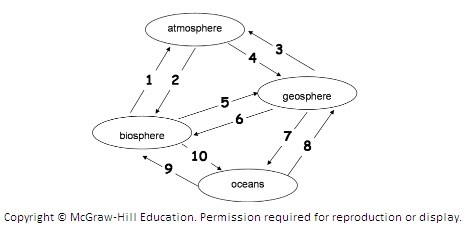Consider that Bangladesh has a surface area of 143,998 square kilometers. How long would it take, at
a growth rate of 1.6%, for there to be one person for every square meter of land surface? What is the
implication of this relative to carrying capacity? What will be an ideal response?
143,998 square kilometers contains 153,998,000,000 square meters. In order to get from a population
of 161,084,000 to a population of 143,998,000,000 it would take a little over 440 years (slightly more
than 10 doublings); the carrying capacity will be reached much sooner.
You might also like to view...
Mudflow is less viscous than Debris flow, and therefore the mudflow moves faster than Debris flow.
a. true b. false
The following diagram illustrates the Carbon Cycle. Each arrow represents the transfer of carbon from one component of the Earth system to another. For example, arrow 1 represents the transfer of carbon from the biosphere to the atmosphere. Match the answers below to the number on the diagram. Match the answer to number 2 on the diagram.
Match the answer to number 2 on the diagram.
A. Fossil fuel formation B. Respiration C. Decay D. Photosynthesis E. Rock formation
The three largest pools of the carbon cycle, in order, are ________
A) fertilizers, plants, and the atmosphere B) sedimentary rock, the atmosphere, and plants C) freshwater streams, the atmosphere, and plants D) oceans, sedimentary rock, and respiration E) sedimentary rock, oceans, and fossil fuels
Which of the following is not explained by the elastic rebound theory?
A. the common occurrence of fires in earthquake-affected communities B. the concept of seismic gap C. the likely recurrence of earthquakes along the same fault zone D. the generation of earthquakes along fault zones